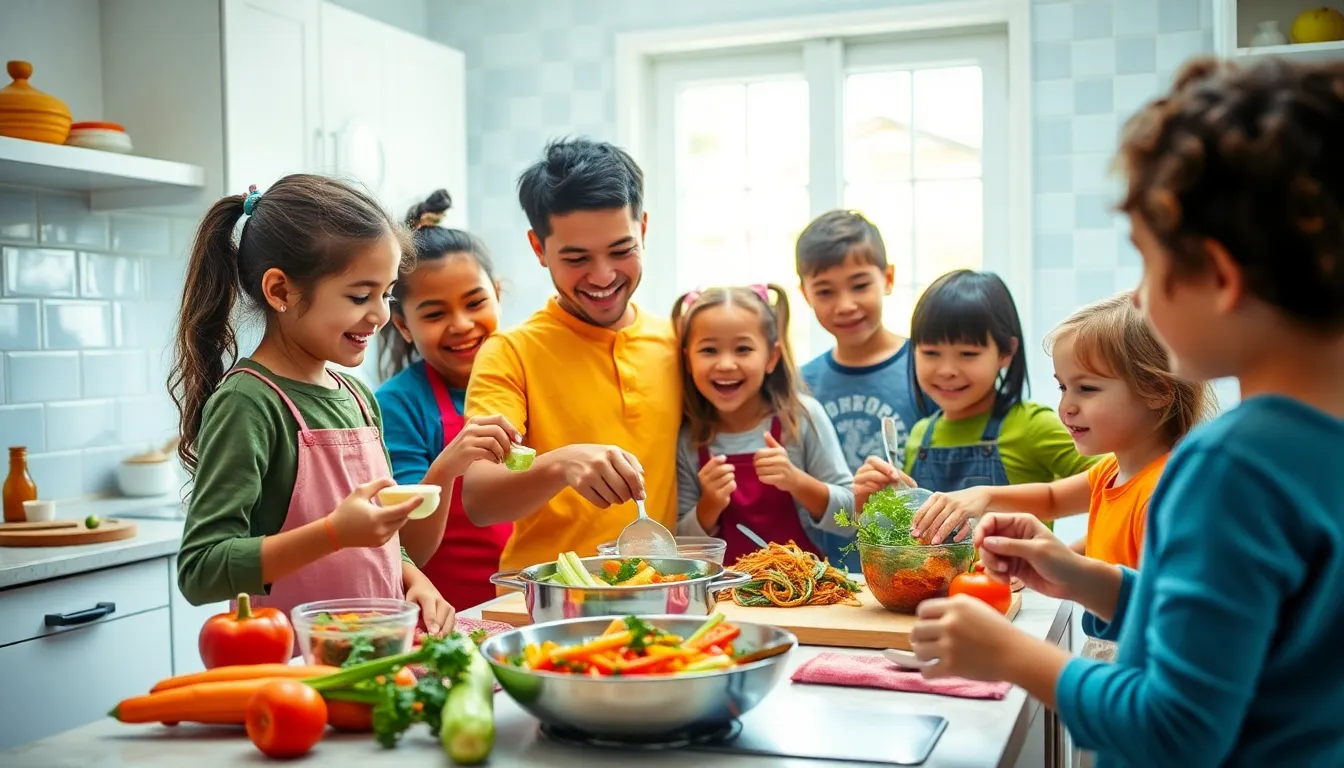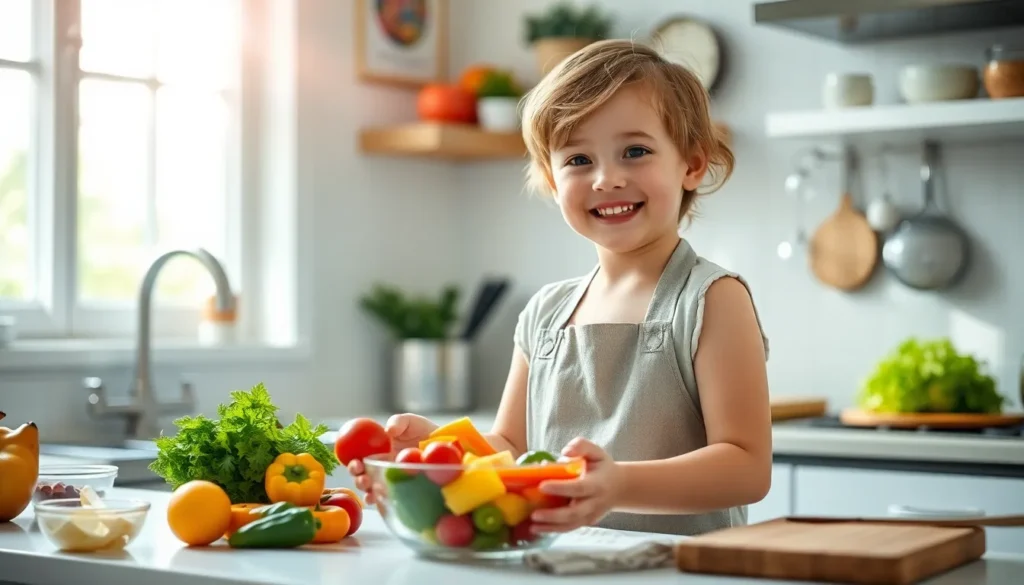Table of Contents
ToggleGetting kids excited about food and nutrition can feel like trying to convince a cat to take a bath. But with the right activities, it’s easier than you think! Engaging children in fun, hands-on experiences not only teaches them about healthy eating but also sparks a lifelong love for nutritious foods.
Benefits of Food and Nutrition Activities for Kids
Engaging kids in food and nutrition activities offers significant benefits. These activities enhance their understanding of healthy eating while promoting positive behaviors.
Enhancing Nutritional Awareness
Understanding nutrition becomes clearer through hands-on activities. Kids learn about different food groups while exploring colors and flavors. Engaging with food fosters curiosity about what goes into their meals. They develop the ability to identify nutritious options and make informed choices. Activities like cooking lessons or garden visits facilitate discussions about nutrients and their roles. Young learners grasp the impact of food on their health and well-being.
Promoting Healthy Eating Habits
Establishing healthy eating habits starts early. Fun cooking activities encourage trying new foods and flavors. Kids experience the satisfaction of preparing meals themselves, making them more likely to enjoy healthy options. Regular involvement in meal planning also reinforces good choices at home. Families that cook together often develop stronger connections around food. As they share these experiences, children adopt positive attitudes toward nutrition from a young age.
Types of Food and Nutrition Activities

Engaging kids in food and nutrition activities can take many forms, and each type provides unique benefits. These hands-on experiences foster a deeper understanding of healthy eating.
Hands-On Cooking Projects
Cooking projects allow kids to participate actively in meal preparation. They gather ingredients, measure portions, and follow recipes, which strengthens their practical skills. For instance, making a vegetable stir-fry introduces various produce types while encouraging children to explore new flavors. Involvement in such activities promotes teamwork, and kids learn to appreciate the effort behind meals. Furthermore, they gain confidence in the kitchen, leading to healthier choices.
Fun Learning Games
Learning games present nutrition concepts in a playful manner. Matching games can help kids identify food groups, while quizzes can test their knowledge about healthy eating habits. For example, a scavenger hunt involving finding healthy foods can create excitement around grocery shopping. Engaging children through play keeps their interest high and solidifies knowledge about nutrition. Ultimately, these games shift their perceptions, turning food education into an enjoyable experience.
Incorporating Food Education into Daily Life
Engaging kids in food education can seamlessly fit into family routines. Activities centered around nutrition not only promote healthy habits but also create lasting memories.
Meal Planning Activities
Involving children in meal planning cultivates their understanding of nutrition. Families can assign kids specific meals to design based on food groups. Discussing their choices reinforces knowledge about balanced diets. Making a grocery list together helps them practice organization and prioritization. Regularly reviewing meals allows kids to express preferences, encouraging healthy decision-making. This structured approach nurtures confidence as they see their ideas come to life on the dinner table. Moreover, they develop essential skills like budgeting when comparing prices for ingredients.
Grocery Store Experiences
Taking kids grocery shopping offers practical lessons about food sourcing. Assigning them tasks, such as finding specific fruits or vegetables, encourages exploration. Identifying seasonal produce teaches them about agriculture and environmental sustainability. Discussing product labels reinforces understanding of nutritional information. Making choices between brands helps kids learn to compare options and consider value. Letting them assist with budgeting solidifies their grasp on making informed decisions. Discussions during shopping trips strengthen communication and reinforce the importance of healthy food selections. Engaging them in these experiences opens the door to lifelong positive eating habits.
Engaging Kids with Interactive Learning
Interactive learning captures children’s interest and makes food education enjoyable. Through hands-on experiences, kids develop a deeper connection to healthy eating.
Using Technology and Apps
Educational apps provide engaging ways for children to learn about nutrition. Games that teach food groups and portion sizes can transform learning into fun activities. Many apps feature interactive quizzes and challenges that encourage kids to explore balanced diets. Additionally, tracking daily food intake through apps enhances their understanding of personal nutrition. Digital platforms can also connect children with virtual cooking classes, offering real-time guidance and inspiration. Kids enjoy sharing their creations online, fostering a sense of accomplishment.
Outdoor Gardening Projects
Outdoor gardening projects offer practical experiences that deepen children’s appreciation for fresh foods. Through planting seeds, watering plants, and watching growth, kids learn about food sources. Experiencing the process of growing vegetables builds excitement when it’s time to harvest and enjoy the produce. Working together in gardens fosters teamwork and teaches responsibility. Families can incorporate seasonal crop choices, allowing kids to discover local produce and adapt meals accordingly. Gardening cultivates curiosity about the natural world, enhancing their understanding of nutrition in a hands-on environment.
Tips for Parents and Educators
Creating a positive atmosphere for food education enhances children’s engagement. Start by removing distractions during meal preparation and discussions about nutrition. Create designated spaces for cooking and learning about food. Ensure these areas are well-lit, organized, and equipped with necessary tools.
Encouraging participation serves to build teamwork and shared experiences. Invite children to join the cooking process, fostering a sense of ownership over their meals. Offer specific tasks to instill confidence. Assign age-appropriate responsibilities, such as washing vegetables or measuring ingredients. Celebrate their contributions, which boosts motivation and interests in healthy choices. Through collaborative efforts, families can strengthen bonds while establishing enjoyable routines that promote nutrition awareness.
Engaging children in food and nutrition activities is a powerful way to instill healthy habits early on. By incorporating fun and interactive experiences, kids can develop a genuine interest in nutritious foods. This not only enhances their understanding of healthy eating but also fosters a sense of curiosity and excitement around meals.
Parents and educators play a crucial role in creating an environment that promotes active participation. Through hands-on cooking, games, and gardening, children can explore food in a meaningful way. These experiences not only cultivate positive attitudes towards nutrition but also strengthen family bonds.
Ultimately, making food education enjoyable lays the groundwork for lifelong healthy choices. By embracing these activities, families can transform mealtime into a delightful journey of discovery and learning.





